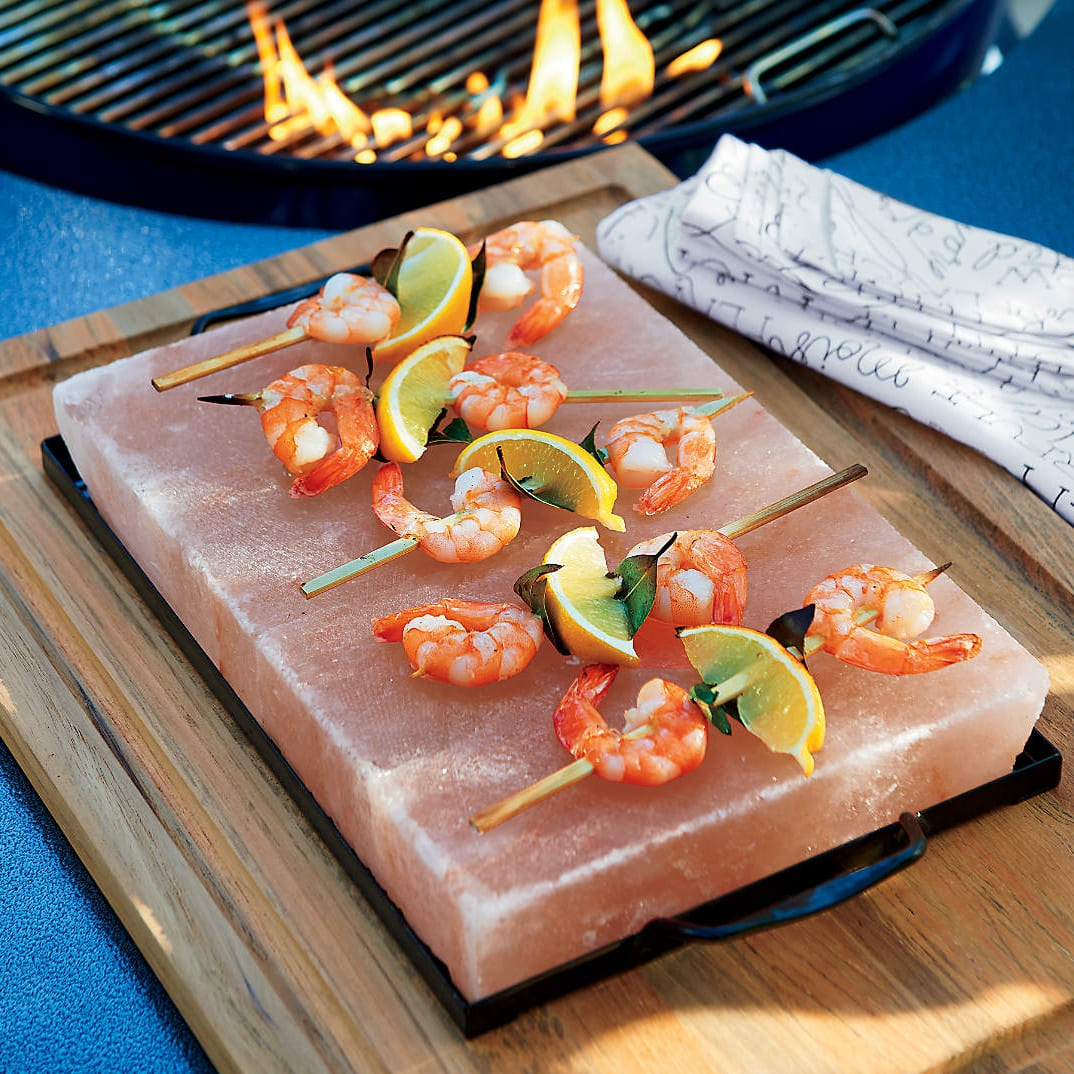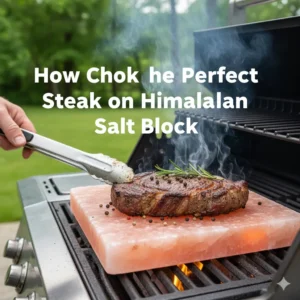Cooking pizza on a Himalayan salt block introduces a distinctive way to achieve crisp, flavor-rich results. Heated properly, the block infuses the crust with a subtle mineral saltiness while helping it bake evenly for a refined, restaurant-quality texture. This method suits both grills and ovens when the block is warmed gradually and the dough kept thin. In this guide, you’ll learn how to prep and heat your salt block, cook safely, and compare the results to traditional pizza stones so you can experiment with confidence at home.

Prerequisites: Tools and Materials
Before cooking pizza on a Himalayan salt block, gather the essential tools to ensure safe handling, even heating, and balanced flavor. Proper preparation supports consistent results whether you’re using a grill or oven. Here’s what you’ll need for a stable setup and efficient cooking process.
- Authentic Himalayan salt block (preferably from the Khewra Salt Mine), weighing about eight to twelve pounds
- Thin-crust pizza dough with light toppings
- Oven, grill, or stovetop capable of gradual heating up to approximately 500°F
- Pizza peel or sturdy spatula for transferring the pizza
- Optional: a dusting of flour or cornmeal to reduce sticking
Each item plays a distinct role—ensuring structural integrity, temperature control, and optimal crust texture. Having everything ready in advance keeps the process seamless and lets you focus fully on achieving precise flavor and doneness.
Premium Himalayan Salt Blocks for Culinary and Hospitality
Partner with Jilin Ever Creation to source genuine pink Himalayan salt blocks directly from the Khewra Salt Mine. Our FDA- and EU-certified natural salt products enhance flavor and presentation across food service, retail, and hospitality settings. Choose from customizable sizes, branding options, and reliable global delivery tailored to your business.

Step-by-Step Guide to Cooking Pizza on a Himalayan Salt Block
Step 1: Gradually Preheat the Salt Block
Proper preheating is essential for safe and effective salt block cooking. Place the block on a grill, stovetop, or in an oven, and gradually increase the temperature in stages every ten minutes. Aim for a final surface temperature between four and five hundred degrees Fahrenheit, depending on your equipment.
Slow heating allows internal moisture to evaporate evenly and prevents cracking. Never expose the block to sudden temperature changes or damp conditions. When it’s fully heated, the surface should appear dry, evenly hot, and gently sizzling—ready for your pizza dough.
Step 2: Prepare and Position the Pizza Dough
Because a salt block radiates heat from below, use a thin crust and light toppings for optimal results. Dense doughs or heavy ingredients can prevent the crust from crisping properly. Lightly dust either the dough or the hot block with flour or cornmeal to minimize sticking.
Using a pizza peel or wide spatula, transfer the prepared dough carefully onto the block. The surface sears the crust instantly, sealing in moisture while imparting a distinctive, understated saltiness unique to this cooking method.
Step 3: Cook and Monitor the Pizza
Once the pizza is placed, cooking happens quickly—typically within five to eight minutes. The block’s heat produces a thin, crisp crust with a clean, balanced salinity. Watch the edges and underside closely, as high surface temperatures can brown the dough faster than expected.
When the cheese has melted and the crust turns golden, lift the pizza from the block and let it rest briefly. The finished result is a light, flavorful flatbread-style pizza—crackly on the outside, delicately seasoned, and distinctly different from one baked on a traditional stone.
Watch the process in this short video tutorial
Flavor and Texture Differences: Salt Block vs. Pizza Stone
Cooking pizza on a Himalayan salt block imparts a flavor and texture distinct from a traditional pizza stone. The salt surface gently seasons the dough, introducing a refined briny note that shifts with the dough’s moisture level and cooking time. The higher the hydration, the more pronounced the salt edge becomes.

The block’s direct, rapid heat promotes an ultra-thin, crisp crust reminiscent of gourmet flatbread. It performs best with light, balanced toppings that cook quickly under intense bottom-up heat. Because of the speed of conduction, excessive toppings can disrupt texture consistency and prevent proper crisping.
By contrast, a ceramic or cordierite pizza stone provides steady, even heat ideal for thicker, chewier crusts. It allows dough to expand gradually and adds no additional seasoning, preserving the traditional pizza flavor profile. For classic Neapolitan or New York–style pizzas, the stone delivers reliability; for a lighter, bolder crust with natural seasoning, the salt block offers an inventive alternative.
Care and Maintenance of Himalayan Salt Blocks for Cooking
Proper maintenance keeps a Himalayan salt block safe for cooking and extends its functional life. After use, allow the block to cool completely before cleaning. Wipe the surface gently with a slightly damp cloth or a soft scrubber to remove food residue. Avoid soap or full immersion in water, as either can cause the salt to dissolve or the block to crack.
Temperature control is just as important as cleaning. Sudden transitions from hot to cold can create internal fractures, so let the block cool gradually after use. Store it in a dry area away from direct humidity to prevent surface erosion or discoloration.
For long-term durability, keep the block in a well-ventilated space with stable conditions. Consistent care preserves its texture and mineral composition, allowing it to continue imparting a subtle, natural salt flavor to pizzas, flatbreads, and grilled dishes.
Safety Tips for Cooking Pizza on a Himalayan Salt Block
Cooking pizza on a Himalayan salt block yields a crisp, savory crust and a distinctive presentation, but it demands precision and patience. Because the block retains extreme heat and reacts to sudden temperature shifts, proper handling is essential to prevent uneven cooking or cracks in the salt.
The following table highlights common mistakes and how to avoid them. Each tip is designed to maintain safety, extend the life of your salt block, and ensure consistent flavor and texture with every use.
| Common Mistake | How to Avoid It |
|---|---|
| Heating the salt block too quickly causes cracking | Raise the temperature in gradual 10-minute increments |
| Using thick crusts or heavily topped pizzas | Choose thin doughs with light toppings for even cooking |
| Placing dough without a barrier layer leads to sticking | Lightly dust the dough or block surface before placing |
| Cleaning with detergents damages the block’s surface | Allow the block to cool fully, then wipe gently with a damp cloth |
With controlled heating, thin dough, and gentle maintenance, a Himalayan salt block can transform simple recipes into refined, flatbread-style pizzas. Treat it as a precision cooking surface—honor its limits, and it will consistently deliver golden, flavor-rich crusts.
Frequently Asked Questions About Himalayan Salt Block Pizza
How can you prevent the pizza dough from becoming too salty?
Use a drier, thinner dough before placing it on the heated salt block. Because moisture draws salt into the crust, reducing hydration keeps the flavor balanced. You can also slightly shorten the cooking time to maintain a mild taste.
Should you use flour or cornmeal on the block?
Avoid using flour or cornmeal directly on the salt block. These powders burn quickly on high heat and leave residue that’s hard to remove. Instead, lightly brush the dough with oil to prevent sticking and allow easy release after cooking.
What temperature should the salt block reach for pizza?
Heat the block gradually to approximately 400–500°F, increasing the temperature in small stages to prevent cracking. Once fully heated, it retains consistent, high heat that crisps the crust within minutes, imparting a delicate saltiness.
Which works better for pizza: a salt block or a pizza stone?
A pizza stone provides steady, dry heat ideal for traditional Neapolitan or New York–style crusts. A salt block produces a thinner, gourmet-style crust with a subtle seasoning and distinctive texture. Each tool offers a different result rather than serving as a direct substitute.
Can you use a salt block in a dedicated pizza oven?
Yes, but proceed carefully. Pizza ovens heat rapidly, so place the salt block during a gradual preheat rather than into a fully hot oven. This minimizes thermal shock and reduces the risk of cracking while ensuring even heat for safe, effective cooking.
Final Thoughts
Cooking pizza on a Himalayan salt block transforms a familiar favorite into a refined experience. The surface imparts a subtle mineral note and produces a thin, crisp crust ideal for gourmet flatbreads. It’s an inventive approach for cooks who want depth of flavor and texture beyond what a traditional pizza stone provides.
Rather than replacing the stone, the salt block offers a complementary technique—a way to explore new results through controlled heating and careful dough preparation. With patience and attention to temperature, you’ll preserve the block and achieve consistent, restaurant‑quality outcomes.
For those who enjoy experimentation, the salt block invites creativity. Try it for your next pizza night to elevate simple ingredients into a crisp, delicately seasoned dish while keeping your classic stone on hand for those chewy, traditional pies.






